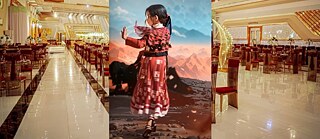Exhibition
Transforming Imagination: Afghan Art Between Tradition and Rebellion

with works by Shiraz Fazli, Parwana Haydar & AVAH Collective, Qeas Pirzad, Shamayel Shalizi and the ArtLords
The exhibition "Transforming Imagination: Afghan Art Between Tradition and Rebellion" shows the exhibition "Afghan Futurism: Transforming Imagination" conceived by Armeghan Taheri and the street art work by the art collective ArtLords at Galerie Eigenheim Weimar as part of the Kunstfest Weimar.
AFGHAN FUTURISM: Transforming Imagination
The artists' works embrace a cultural aesthetic that is both historical and dreamlike, allowing a look forward and a look back at the same time. In this tension between tradition and rebellion, which serves as both reference and mask, new emancipated truths are created outside the dominant cultural narratives. Together, the artists attempt to develop a collective vision for the future derived from the experiences of the Afghan diaspora.
Works
Shiraz Fazli: تکھ تکھ تکھ می شوم (I break apart)Traditional Afghan garments are pieced together from patterned fabrics, mirrors, beadwork, and embroidery. They may also be adorned with hanging, beaded talismans called gul-e-peran and as such offer the body both protection both physically and psychically. تکھ تکھ تکھ می شوم (I break apart) is a tapestry comprised of an assortment of found materials. Pieces of fabric, rice bags, ragdolls, paintings, used clothing, mirrors, beads, and sequins come together to form a collage that resembles traditional Afghan textile work and reflects on the hybrid nature of Afghan cultural artforms.
Qeas Pirzad: The daybreak of utopia
When the rainfall washes away the last cries of despair
And the sun rays dry the last tears of sorrow
The smiles emerge from each corner of the land
From the westernmost point of Herat to the farthest east of Badakhshan
Lighting up the dark and forgotten homes
Calling the forsaken ones to return
Because the sun is rising in our home
Parwana Haydar: Foot ache
Foot ache is a video collage of an AI generated young Afghan girl dancing on rubble, to the traditional frame drum daira, in the changing background of empty opulent Kabul wedding halls. In the glittery, kitsch, hi-tech wedding halls of Kabul, Afghanistan exists an isolated form of liberation for the lucky few who are invited to wedding ceremonies under the current Taliban regime. Women wear their finest dresses in multiple colors of chiffon and twirl to the rhythm of cassettes and classical Afghan music. Afghan futurism may exist in this temporary space of dance and joy, whilst outside on Kabul’s streets remains a dystopia for many women who are forced to wear shapeless gowns and most recently are banned from Universities.
Shamayel Shalizi: جنگ چریکی / جیپ چروکی (Transliteration: Jang Chirki/Jeep Cherokee; Translation: Guerilla Warfare/Jeep Cherokee)
This work is part of a series of large-scale paintings that address the years following the U.S. invasion of Afghanistan and one of the justifications for that invasion: saving Afghan women from Afghan men. Having grown up in Kabul during these years, Shamayel wants to highlight the dichotomy of the hypo-sexualization of Afghan women and the hyper-sexualization of Afghan women. The painting uses recognizable symbols such as the surveillance balloon installed by the Americans and their allies that hung over Kabul and watched the citizens of Kabul for years; there was not an inch in Kabul where one could escape the eyes of the oppressors, a dehumanizing and undignified reminder of life under war and occupation. The narcotica houses depicted in the background - architecture built with opium money - serve to pay tribute to the members of the upper class of Afghan society who participated in the sellout of their country and their people and who collaborated with the oppressors, greed and excess, as well as some of the hidden truths about the real reasons for this occupation. At the same time, there are also symbols in the work that indicate that Afghanistan was exploited and dominated by foreign countries for decades before 2001. Finally, there are symbols that illustrate the strength of the Afghan spirit and show that this spirit will always prevail.
Artists:


Parwana

AVAH (Afghan Visual Arts & History) is an independent and global research collective and multimedia platform. It arose due to the lack of available information and long-term initiatives on the historical and contemporary practices originating in or related to Afghanistan. By collecting art histories, contextualizing practices and creating a professional network, AVAH aims to create important resources that contribute to the understanding of the past and equip the current generation of artists and cultural workers at home and abroad.

RE-set: Art in Exile
Work

ArtLords
Omaid Sharifi is an artist, president and CEO of Wartists and ArtLords, and a fellow at Harvard University. Omaid Sharifi is a board member of CIVICUS, as well as a board member and alumni of the Atlantic Council's Millennium Leadership Program and a recipient of the Global Pluralism Award.Kabir Mokamel was fascinated by art and the diversity of artistic expression from an early age. In the beginning of his art making, Kabir was inspired by his cultural heritage and his own experiences. His artworks deal with politics, religion, history, displacement and identity. With his thought-provoking images and symbolism, Kabir invites viewers to self-reflection, fostering a deeper understanding of the world around us. His art serves as a catalyst for dialogue, challenging preconceptions and encouraging constructive conversations. Through his art, Kabir aims to raise awareness, stimulate dialogue, and bring about positive change in society.
Accompanying programme
The exhibition will be accompanied by the short film program "Khirkee Stories" by the Simurgh Centre in New Delhi. The four short films, which were made in March 2022 as part of a workshop with director Zamarin Whadat, portray Delhi's streets and residents from the perspective of the Afghan community.
In addition, there is a selection of contemporary literature, such as the magazine "What`s Afghan Punk Rock, Anyway?", as well as a diverse radio programme with contributions from Afghan artists who participated in the Goethe-Institute in Exile's Afghanistan Festival.
Exhibition opening: 23 August 2023 at 7 p.m.
Opening hours: Thurs. - Sat. 16 - 19 h and by appointment
Contact: team@galerie-eigenheim.de
The exhibition "Transforming Imagination: Afghan Art Between Tradition and Rebellion" takes place in cooperation with Galerie EIGENHEIM Weimar/Berlin with the kind support of the Kulturstiftung des Freistaates Thüringen in the Gärtnerhaus of the Weimarhallenpark.
Details
Galerie Eigenheim Weimar
Asbachstraße 1
99423